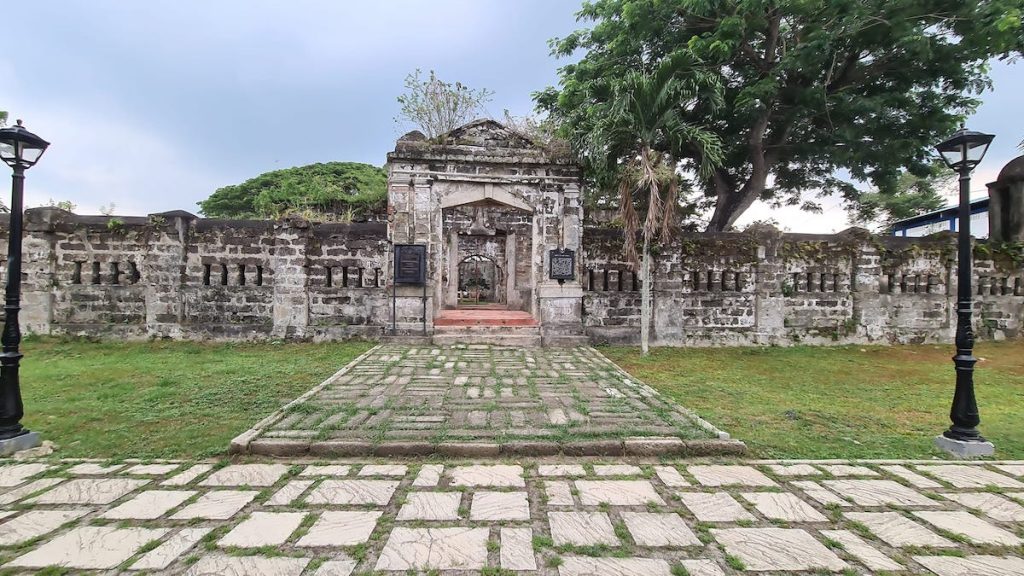Cuartel de Santo Domingo: Old Spanish barracks building in Santa Rosa, Laguna
8 min read
Cuartel de Santo Domingo: History and Significance
The Cuartel de Santo Domingo, also known as Fort Santo Domingo, is a historical site in Santa Rosa, Laguna, Philippines. Built in 1877, the Spanish-era barracks building was originally intended to protect Silang against bandits. With walls made of adobe stones, the entire fort takes up 8.2 hectares of land. Today, it is used as the headquarters of the Special Action Force of the Philippine National Police.
The National Museum recently declared the Cuartel de Santo Domingo an Important Cultural Property of the Philippines. Dubbed as the “Intramuros of the South,” the fort is a significant reminder of the country’s colonial past. Despite its rich history, the Cuartel de Santo Domingo is perhaps best known as a detention facility for high-profile crime suspects in recent years. Alleged pork barrel scam mastermind Janet Lim-Napoles was held inside the compound in 2013.
For history buffs, the Cuartel de Santo Domingo is a must-visit destination. The Spanish-era adobe structure is an advance post of the Guardia Civiles meant to deter brigands from Cavite. In 2005, the fort was declared a historical site and has since been preserved as a testament to the country’s past. The Cuartel de Santo Domingo is a unique blend of history, culture, and architecture, making it a must-see destination for anyone visiting the Philippines.
Historical Background
Cuartel de Santo Domingo, also known as Fort Sto. Domingo is an old two-storey Spanish barracks building in Santa Rosa, Laguna, Philippines. It was built in 1877 and declared a National Historical Landmark in 2005. The Spanish-era adobe structure served as an advance post of the Guardia Civil, a Spanish police force meant to deter brigands from Cavite from attacking Santa Rosa.

During the Philippine Revolution, the Spanish colonial government used the fort as a military barracks and prison. General Jose Lachambre, the highest-ranking Spanish official in Laguna, was imprisoned in the fort by revolutionary forces led by General Emilio Aguinaldo.
After the revolution, the fort was occupied by the Dominican Order and used as a seminary until the 1980s. In the 1990s, the Philippine National Police acquired the property and converted it into the headquarters of the Special Action Force.
Today, the Cuartel de Santo Domingo is an Important Cultural Property of the Philippines, recognized by the National Museum. The fort is a significant historical site reflecting the country’s colonial past and struggle for independence.

Location and Structure
The fort’s walls are made of adobe stones, showcasing the Spanish-era ruins. It has a rectangular shape with four bastions at each corner. The building has a total of 16 rooms, with each room having a fireplace and a window. The second floor of the building is accessible by a wooden staircase, and it has a balcony that provides a stunning view of the surrounding area.
Cuartel de Santo Domingo is located near the South Luzon Expressway (SLEX) and is easily accessible from Manila. It is situated in Barangay Santo Domingo, which is a few kilometers away from the city proper of Santa Rosa. The fort’s location provides a perfect opportunity for visitors to explore the nearby cities of Calamba, Laguna, and Silang, Cavite.
Cuartel as a Training Camp and Detention Facility
Cuartel de Santo Domingo, a Spanish-era fort in Laguna, serves as a training camp for the Philippine National Police’s Special Action Force (SAF) and a detention center for high-profile detainees. The fort covers an area of 8 hectares and is considered an Important Cultural Property of the Philippines by the National Museum.
In recent years, Cuartel de Santo Domingo gained notoriety as a detention facility for many big-time political detainees such as former President Joseph Estrada, Moro National Liberation Front (MNLF) chair Nur Misuari, and former Senator Gregorio Honasan. Janet Lim-Napoles, the alleged mastermind behind the pork barrel scam, was also held inside the compound in 2013.
Despite being a detention center for high-profile crime suspects, Cuartel de Santo Domingo is primarily used as a training camp for the SAF. The SAF is the elite unit of the Philippine National Police, responsible for handling high-risk operations such as counter-terrorism, hostage rescue, and high-profile arrests.
The SAF conducts various types of training at Cuartel de Santo Domingo, including marksmanship, close-quarters combat, and tactical driving. The fort’s vast open spaces and rugged terrain provide an ideal training ground for the SAF.
In addition to the SAF, other units of the Philippine National Police also conduct training at Cuartel de Santo Domingo. The fort’s historical significance and strategic location make it an ideal training ground for law enforcement personnel.
Despite its dual role as a training camp and detention facility, Cuartel de Santo Domingo remains an important cultural property of the Philippines. The National Museum recognizes the fort’s historical and cultural significance and has taken steps to preserve it for future generations.

Cuartel in Modern Times
Cuartel de Santo Domingo has undergone several transformations over the years. It has served different purposes and has been occupied by various entities. Today, it is a historical site that serves as the headquarters of the Special Action Force of the Philippine National Police.
In recent years, the Cuartel has been declared an Important Cultural Property of the Philippines by the National Museum. This recognition has led to efforts to preserve and restore the site.
Janet Lim-Napoles, the alleged pork barrel scam mastermind, was held inside the Cuartel in 2013. The detention of high-profile crime suspects in the compound has earned it a reputation as a detention facility.
During the Japanese occupation, the Cuartel was used as a depository of ammunition and cannon balls. Its strategic location made it a target of the Japanese Imperial Army. The Cuartel was heavily bombed during the war, resulting in the destruction of several buildings.
Former President Joseph Estrada once proposed to convert the Cuartel into a museum. However, the proposal was not realized due to a lack of funding and support from the local government.
Today, the Cuartel serves as a reminder of the country’s rich history. It is a popular destination for tourists and history buffs. Gemma Batino, a local historian, has been leading efforts to promote the Cuartel and its historical significance.
The Kilusan Cuartel de Santo Domingo, a group of heritage advocates, has been pushing for the preservation and restoration of the Cuartel. The group has been lobbying Congress and the National Historical Commission of the Philippines to allocate funds for the preservation of the site.
Mayor Danilo Fernandez of Santa Rosa has expressed his support for the preservation of the Cuartel. He has stated that the local government is committed to working with heritage advocates to ensure that the Cuartel remains a historical site for future generations.
In 2005, a historical marker was installed at the Cuartel by the National Historical Institute. The marker recognizes the Cuartel as a historical site that played a significant role in the country’s history.
Despite its turbulent past, the Cuartel has stood the test of time. It remains an important part of the country’s heritage and a testament to the resilience of the Filipino people.
Ownership and Management
The Cuartel de Santo Domingo is a historical site located in Santa Rosa, Laguna in the Philippines. It was built in the 1870s as an outpost for the guardia civil and served as a Spanish barracks during the colonial era. Today, it is used as the headquarters of the Special Action Force of the Philippine National Police.
Ownership of the 8.2-hectare property is a contentious issue. Kilusan Cuartel de Santo Domingo, a local organization, has been advocating for the return of the property to the local government since 2000. They argue that the property should not be on the list of military/police properties and should be managed by the local government instead.
In recent years, the National Museum has recognized the Cuartel de Santo Domingo as an Important Cultural Property of the Philippines. This designation is a legal recognition that provides protection and conservation measures for the site. The National Museum has also conducted several heritage studies and conservation projects to preserve the historical and cultural significance of the site.
The management of the Cuartel de Santo Domingo is currently under the jurisdiction of the Philippine National Police. The site is open to the public, but visitors are required to secure permission from the authorities before entering the premises. Despite the ongoing ownership dispute, the local government and the Philippine National Police have expressed their commitment to preserving the historical and cultural significance of the site.
While the property is currently under the management of the Philippine National Police, local organizations and the National Museum have advocated for its preservation and conservation. The site’s historical and cultural significance continues to attract visitors and researchers alike, and efforts to protect and conserve the site are ongoing.
Frequently Asked Questions
What is the historical significance of Cuartel de Santo Domingo?
Cuartel de Santo Domingo is a Spanish-era fort located in Santa Rosa, Laguna, Philippines. It was built in 1877 as an outpost for the guardia civil. The fort played a significant role in protecting Silang against bandits, which was a major concern during the Spanish colonial period. Today, it is considered an important cultural property of the Philippines and a testament to the country’s rich history.
Where is Cuartel de Santo Domingo located?
Cuartel de Santo Domingo is located in Santa Rosa, Laguna, Philippines. It covers over eight hectares of land and is often called the Intramuros of the South.
What are some nearby attractions to Cuartel de Santo Domingo?
Santa Rosa, Laguna is a popular tourist destination in the Philippines. Some nearby attractions to Cuartel de Santo Domingo include the Enchanted Kingdom, a theme park that features thrilling rides and attractions, and the Paseo de Santa Rosa, a shopping center that boasts a variety of stores and restaurants.
What is the history of Santa Rosa, Laguna?
Santa Rosa, Laguna, has a rich history that dates back to the Spanish colonial period. It was once a small farming community known for its fertile land and abundant natural resources. Today, it is a bustling city home to numerous businesses and industries.
What are some notable historical places in Santa Rosa, Laguna?
Aside from Cuartel de Santo Domingo, there are several other notable historical places in Santa Rosa, Laguna. These include the Santa Rosa de Lima Parish Church, built in the 18th century and considered a national treasure, and the Malayan Colleges Laguna, established in 1965 and has played a significant role in promoting education and innovation in the Philippines.
Laguna, Philippines Travel and Tour Packages
Want more updates about new package tours and tourist attractions in Laguna, Philippines, that you can add to your itinerary?
Follow the Out of Town Travel Blog on Facebook, Twitter, Instagram, and Pinterest if you want more travel and food-related updates.
Read:





